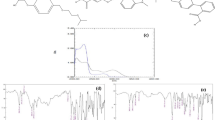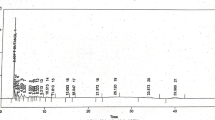Abstract
Hawthorn leaves, officially listed in the 2015 Chinese Pharmacopoeia, comes from Crataegus pinnatifida Bge. var. major N. E. Br. and Crataegus pinnatifida Bge. It has the effect of invigorating blood and dissolving stasis, regulating qi and dredging veins, turbid, and lipid-lowering. This work was designed to explore the spectrum–effect relationship between high-performance liquid chromatography (HPLC) fingerprint and the invigorating blood and dissolving stasis effect of hawthorn leaves. Four extracts from hawthorn leaves, 50% ethanol extract (EE), macroporous resin extract (MRE), ethyl acetate extract (EAE), and n-butanol extract (BAE) were administered to rats at three doses of 0.4 g·kg−1, 0.6 g·kg−1, and 0.8 g·kg−1 (crude medicine weight/rat weight), respectively. Twenty-seven indexes were obtained and analyzed by principal component analysis (PCA) and one-way ANOVA. The spectrum–effect relationship was constructed by multiple linear regression (MLR) analysis. With the above separation method, HPLC fingerprints of 12 batches (three concentrations of four extracts) of hawthorn leaves extracts were obtained, and 32 common peaks were marked by similarity analysis. Additionally, 9 indexes of fibrinogen (FIB), erythrocyte total (ET), platelet count (PC), mean platelet volume (MPV), plateletcrit (PCT), whole blood viscosity-WBV(LSR-20S−1), WBV(LSR-60S−1), WBV(LSR-150S−1), and plasma viscosity (PV) were selected as the relevant indexes with pertinence and statistical significance (p < 0.05) on invigorating blood and dissolving stasis, and taken for the subsequent spectrum–effect experiments. Finally, the results of spectrum–effect relationships between 32 common peaks and 9 indexes showed the main peaks responsible for invigorating blood and dissolving stasis were 1–6, 8–11, 13–15, 17, 19, 21, 23, and 27–32. Compared with the standards and other references, peaks 3, 14, 17, and 19 were, respectively, identified as chlorogenic acid, vitexin glycoside, vitexin, and rutin. This work was helpful to the discovery of the active substance and quality control of hawthorn leaves.
Graphic Abstract






Similar content being viewed by others
References
Fu Y, Yang JC, Cunningham AB, Towns AM, Zhang Y, Yang HY, Li JW, Yang XF (2018) A billion cups: The diversity, traditional uses, safety issues and potential of Chinese herbal teas. J Ethnopharmacol. 222:217–228
Tang DQ, Li Z, Jiang XL, Li YJ, Du Q, Yang DZ (2014) Fingerprint analysis and multi-ingredient quantitative analysis for quality evaluation of Xiaoyanlidan tablets by ultra high performance liquid chromatography with diode array detection. J Sep Sci 37:2131–2137
Dong RF, Su J, Nian H, Shen H, Zhai X, Xin HL, Qin LP, Han T (2017) Chemical fingerprint and quantitative analysis of flavonoids for quality control of Sea buckthorn leaves by HPLC and UHPLC-ESI-QTOF-MS. J Funct Foods 37:513–522
Cheng J, He SY, Wan Q, Jing P (2018) Multiple fingerprinting analyses in quality control of Cassiae Semen polysaccharides. J. Chromatogr B 1077–1078:22–27
Guo H, Zhang Z, Yao Y, Liu J, Chang R, Liu Z, Hao H, Huang T, Wen J, Zhou T (2018) A new strategy for statistical analysis-based fingerprint establishment: Application to quality assessment of Semen sojay praeparatum. Food Chem 258:189–198
Zhang XF, Chen J, Yang JL, Shi YP (2018) UPLC-MS/MS analysis for antioxidant components of Lycii Fructus based on spectrum-effect relationship. Talanta 180:389–395
Xiao RY, Wu LJ, Hong XX, Tao L, Luo P, Shen XC (2018) Screening of analgesic and anti-inflammatory active component in Fructus Alpiniae zerumbet based on spectrum-effect relationship and GC-MS. Biomed Chromatogr 32:4112
Jiang ZM, Zhao C, Gong XJ, Sun X, Li HD, Zhao Y, Zhou X (2018) Quantification and efficient discovery of quality control markers for Emilia prenanthoidea DC. by Fingerprint-Efficacy Relationship Modeling. J Pharm Biomed Anal 156:36–44
Chen YQ, Yu HL, Wu H, Pan YZ, Wang KL, Liu LP, Jin YP, Zhang CC (2015) Tracing novel hemostatic compounds from heating products of total flavonoids in Flos Sophorae by spectrum-effect relationships and column chromatography. J Sep Sci 38:1691–1699
Chen YQ, Yu HL, Wu H, Pan YZ, Wang KL, Liu LP, Jin YP, Zhang CC (2015) A novel reduplicate strategy for tracing hemostatic compounds from heating products of the flavonoid extract in Platycladi Cacumen by spectrum-effect relationships and column chromatography. Molecules 20:16970–16986
Shen CH, Liu CT, Song XJ, Zeng WY, Lu XY, Zheng ZL, Pan J, Zhan RT, Yan P (2018) Evaluation of analgesic and anti-inflammatory activities of Rubia cordifolia L. by spectrum-effect relationships. J Chromatogr B 1090:73–80
Lü SW, Dong SY, Xu D, Duan JX, Li GY, Guo YY, Kuang HX, Wang QH (2017) Spectrum-effect relationships between fingerprints of Caulophyllum robustum Maxim and inhabited pro-inflammation cytokine effects. Molecules 22:1826
Liu M, Wu Y, Huang S, Liu H, Feng J (2018) Spectrum-effect relationship between HPLC fingerprints and hypolipidemic effect of Curcuma aromatic. Biomed Chromatogr 32:4220
Xu GL, Xie M, Yang XY, Song Y, Yan C, Yang Y, Zhang X, Liu ZZ, Tian YX, Wang Y, Jiang R, Liu WR, Wang XH, She GM (2014) Spectrum-effect relationships as a systematic approach to traditional Chinese medicine research: current status and future perspectives. Molecules 19:17897–17925
Zhu CS, Lin ZJ, Xiao ML, Niu HJ, Zhang B (2016) The spectrum-effect relationship—a rational approach to screening effective compounds, reflecting the internal quality of Chinese herbal medicine. Chin J Nat Med 14:177–184
Li HL, Song FR, Xing JP, Tsao R, Liu ZQ, Liu SY (2009) Screening and structural characterization of α-Glucosidase inhibitors from Hawthorn Leaf Flavonoids extract by Ultrafiltration LC-DAD-MSn and SORI-CID FTICR MS. J Am Soc Mass Spectr. 20:1496–1503
Wang CH, Wang YX, Liu HJ (2011) Validation and application by HPLC for simultaneous determination of vitexin-2″-O-glucoside, vitexin-2″-O-rhamnoside, rutin, vitexin, and hyperoside. J Pharm Anal 1:291–296
Edwards JE, Brown PN, Talent N, Dickinson TA, Shipley PR (2012) A review of the chemistry of the genus Crataegus. Phytochemistry 79:5–26
Huang XX, Guo DD, Li LZ, Lou LL, Li DM, Zhou CC, Peng Y, Song SJ (2013) Monoterpene and sesquilignan compounds from the leaves of Crataegus pinnatifida. Biochem Syst Ecol 48:1–5
Li HJ, Liu Y, Jin HZ, Liu SJ, Fang ST, Wang CH, Xia CH (2015) Separation of vitexin-4″-O-glucoside and vitexin-2″-O-rhamnoside from hawthorn leaves extracts using macroporous resins. J Chromatogr B 1007:23–29
Choi JS, Islam MN, Ali MY, Kim EJ, Kim YM, Jung HA (2014) Effects of C-glycosylation on anti-diabetic, anti-Alzheimer’s disease and anti-inflammatory potential of apigenin. Food Chem Toxicol 64:27–33
Li LZ, Gao PY, Song SJ, Yuan YQ, Liu CT, Huang XX, Liu QB (2015) Monoterpenes and flavones from the leaves of Crataegus pinnatifida with anticoagulant activities. J Funct Foods 12:237–245
He M, Min JW, Kong WL, He XH, Li JX, Peng BW (2016) A review on the pharmacological effects of vitexin and isovitexin. Fitoterapia 115:74–85
Dong PZ, Pan LL, Zhang XT, Zhang WW, Zhu Y (2017) Hawthorn (Crataegus pinnatifida Bunge) leave flavonoids attenuate atherosclerosis development in apoE knock-out mice. J Ethnopharmacol. 198:479–488
Dalli E, Vallés J, Cosín-Sales J, Santos MT, Moscardó A, Milara J, Sotillo JF (2011) Effects of hawthorn (Crataegus laevigata) on platelet aggregation in healthy volunteers. Thromb Res 128:398–400
Shatoor AS, Soliman H, Al-Hashem F, El-Gamal B, El-Menshawy N (2012) Effect of Hawthorn (Crataegusaronia syn. Azarolus (L)) on platelet function in albino wistar rats. Thromb Res 130:75–80
Zhang JY, Liang RX, Wang L, Yan RY, Hou R, Gao SR, Yang B (2013) Effects of an aqueous extract of Crataegus pinnatifida Bge. var. major N. E. Br. fruit on experimental atherosclerosis in rat. J Ethnopharmacol. 148:563–569
Rastogi S, Pandey MM, Rawat AKS (2016) Traditional herbs: a remedy for cardiovascular disorders. Phytomedicine 23:1082–1089
Wang X, Du YL, Li YR, Zhao SN, Pan WD, Pan HF (2014) A simple and sensitive method for the simultaneous determination of six constituents in hawthorn leaves. Anal Methods 6:7475–7483
Dang X, Miao JJ, Chen AQ, Li P, Chen L, Liang JR, Xie RM (2015) The antithrombotic effect of RSNK in blood-stasis model rats. J Ethnopharmacol. 173:266–272
Xi SY, Gong YW (2017) Essentials of Chinese Materia Medica and Medical Formulas. Academic Press, Salt Lake City, pp 227–256
Kuligowski J, Pérez-Guaita D, Lliso I, Escobar J, León Z, Gombau L, Solberg R, Saugstad OD, Vento M, Quintás G (2014) Detection of batch effects in liquid chromatography-mass spectrometry metabolomic data using guided principal component analysis. Talanta 130:442–448
Stevenson PG, Burns NK, Purcell SD, Francis PS, Barnett NW, Fry F, Conlan XA (2017) Application of 2D-HPLC coupled with principal component analysis to study an industrial opiate processing stream. Talanta 166:119–125
Wang J, Xiong X, Feng B (2014) Aspirin resistance and promoting blood circulation and removing blood stasis: Current situation and prospective. Evid Based Complement Alternat Med 7330:954863
Zhang JX, Feng Y, Li SD, Liu Y, Zhang Y, Guo YX, Yang MH (2017) Microvascular pathological features and changes in related injury factors in a rat acute blood stasis model. J Tradit Chin Med 37:108–115
Choi TY, HeeJun J, Park B, AhLee J, You S, Jung J, SooLee M (2016) Concept of blood stasis in Chinese medical textbooks: A systematic review. European J Integr Med 8:158–164
Chen C, Wang FQ, Xiao W, Xia ZN, Hu G, Wan JB, Yang FQ (2017) Effect on platelet aggregation activity: extracts from 31 Traditional Chinese Medicines with the property of activating blood and resolving stasis. J Tradit Chin Med 37:64–75
Acuña JM, de la Cruz MH, Ros AL, Tapia SP, Ginés MLM, de Andrés Frutos CD (2017) Elevated plasma fibrinogen levels in multiple sclerosis patients during relapse. Mult Scler Relat Disord 18:157–160
Naveed M, Hejazi V, Abbas M, Kamboh AA, Khan GJ, Shumzaid M, Ahmad F, Babazadeh D, Xia FF, Modarresi-Ghazani F, Li WH, Zhou XH (2018) Chlorogenic acid (CGA): A pharmacological review and call for further research. Biomed Pharmacother 97:67–74
Ganeshpurkar A, Saluja AK (2017) The pharmacological potential of Rutin. Saudi Pharm J 25:149–164
Zou ZJ, Liu ZH, Gong MJ, Han B, Wang SM, Liang SW (2015) Intervention effects of puerarin on blood stasis in rats revealed by a 1H NMR-based metabonomic approach. Phytomedicine 22:333–343
Wu JQ, Wei P, Qin RX, Zhou H (2014) Crataegus pinnatifida: chemical constituents, pharmacology, and potential applications. Molecules 19:1685–1712
Acknowledgements
This work were supported by the Key Project of Natural Science Research Program of Chengde Medical University (Grant Number 201811), the Key Discipline Construction Projects of Higher School (Grant Number 2013.4), and Science and Technology Research Key Project of Higher School in Hebei Province, China (Grant Numbers ZD2015097 and QN2017005). The funding bodies played no role in study design, data acquisition, analysis and interpretation, or manuscript preparation and submission.
Author information
Authors and Affiliations
Corresponding author
Ethics declarations
Conflict of Interest
All authors declare that they have no conflict of interest.
Ethical Approval
The experimental program was approved by the Animal Ethics Committee of Chengde Medical University and conformed to the National Institute of Health and Nutrition Guide for Care and Use of Laboratory Animals.
Additional information
Publisher's Note
Springer Nature remains neutral with regard to jurisdictional claims in published maps and institutional affiliations.
Electronic supplementary material
Below is the link to the electronic supplementary material.
Rights and permissions
About this article
Cite this article
Xu, B., Gao, J., Zhao, S. et al. The Spectrum–Effect Relationship Between HPLC Fingerprint and the Invigorating Blood and Dissolving Stasis Effect of Hawthorn Leaves. Chromatographia 83, 409–421 (2020). https://doi.org/10.1007/s10337-020-03861-8
Received:
Revised:
Accepted:
Published:
Issue Date:
DOI: https://doi.org/10.1007/s10337-020-03861-8




